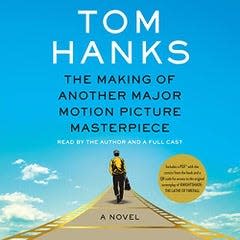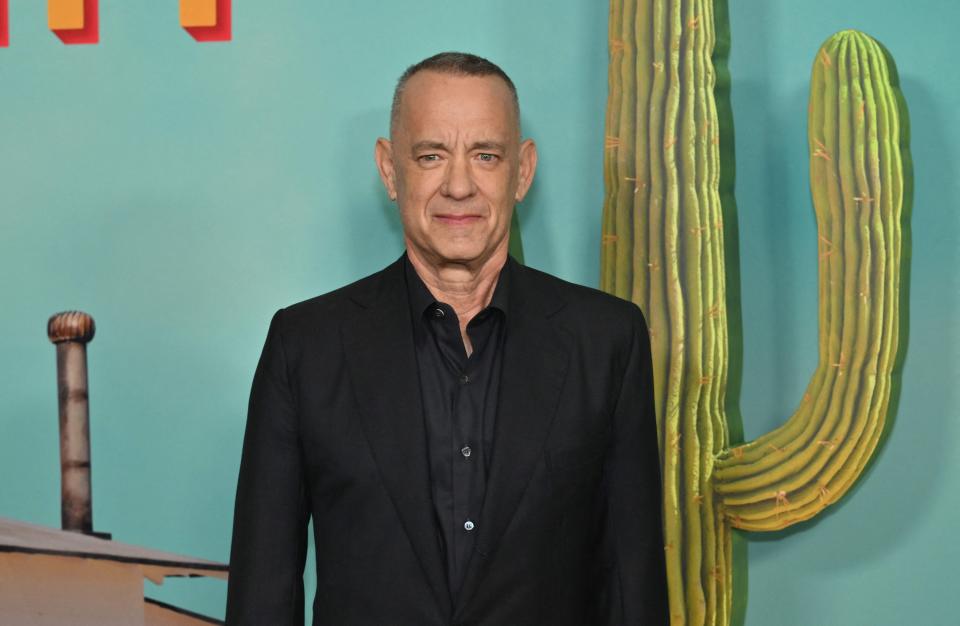How Tom Hanks' new novel dances around the reality of movie masterpieces
- Oops!Something went wrong.Please try again later.

If you’re trying to squeeze in one more summer read, you might be surprised to know Tom Hanks has written a book about moviemaking. Regrettably, it’s not non-fiction — because that would be a doozy.
Who else has a career like Hanks? Becoming a star by dressing in drag. Beating Harrison Ford and Robert DeNiro for the lead in “Big.” Winning back-to-back acting Oscars. (Only Spencer Tracy can claim the same feat.) Starring in and producing countless hits. Losing and gaining massive amounts of weight for parts. Co-starring alongside Madonna, Hooch and Wilson.
But “The Making of Another Motion Picture Masterpiece” is a work of fiction, a story tracing the filmmaking process from source material to the moment it unfurls on a big screen. The novel takes its time building up characters both major and minor. The reader learns a lot about the assistants and make-up artists who make a major production hum. Which seems to be Hanks' point: to highlight the unsung heroes of the film industry.
It’s another example of a major talent paying tribute to the movie magic that made them rich and famous. While it doesn’t always track with reality, “Masterpiece” makes for a whimsical insight into Hanks’ view of the industry.
Here's the set-up: a novelist is asked to chronicle the making of “Knightshade: The Lathe of Firefall,” a comic-book movie. But writer-director Bill Johnson incorporates his own vision, uncovering an obscure graphic novel that chronicles the story of a soldier who saves the day with his trusty flamethrower.
Hanks takes us into the origin story of this obscure comic, the illustrator basing his character off an uncle who served in the Pacific Theater. Hanks never misses a chance to insert an earnest reference to World War II — the “good war” — into his work.
Despite the Marvel(ish) studio’s plan for spinoffs and decade-spanning sequels, Johnson is allowed to turn this fantastical epic into a quiet character piece. Hanks takes us through writing the screenplay and pre-production, where we meet Johnson’s faithful producer Al (short for Alicia). Al shepherds the process of securing production offices, scouting shooting locations, and hiring the staff. We get Al’s whole story, from working the front desk of a Virginia hotel to Hollywood power player.
Then there’s the casting. Wren Lane is the hot actress who gets the lead and deals with a barrage of sexism and stalkers. The male lead is trickier, with the initial casting of a young gun with lots of ego. But we even get extensive backstories on bit players that eventually pay off in the long run of the book.
At last the reader reaches the shoot, where Hanks’ thesis starts to take shape. Movies are miracles, the author argues, brought together by the chemistry of hundreds of professionals working together. If a film works, it's in defiance of endless efforts to undo the best intentions of everyone involved.

That miracle transcends to the audience as “Masterpiece” ends with the aged creator of the Firefall comic book sitting in a darkened room, seeing his uncle come back to life from a cinematic creation of smoke and heat.
We’ve seen directors in the wake of COVID make their love letters to the cinema. From Kenneth Branagh (“Belfast”) to Sam Mendes (“Empire of Light”), there’s a consistent message about the transformative powers of moviemaking and moviegoing.
Hanks offers the same argument here, though there are mixed messages. Not only has he chosen a fictional comic-book film to chronicle — a genre Hanks has not soiled himself with — but one being produced for a streaming company! The heresy!
That decision doesn’t even make sense, as the book ends with “Knightshade” being deemed good enough to get a limited run in the multiplexes. Why even mention streaming if you end your story with the power of seeing a movie in the theater?
No doubt Hanks wants to capture the current state of things. But Hanks is so nostalgic that his prose often seems at conflict with the structure of his novel. Yes, Bill Johnson is making a visual effects extravaganza for a streaming service. Yet he still writes his scripts on manual typewriters (we get extensive descriptions of the types he likes to use). Which doesn’t quite gel with the notion that Johnson really gets the modern moviegoing audience.
Many critics have taken issue with the extensive details Hanks infuses into “Masterpiece.” I disagree — I like a story that takes its time and fills in the blanks. The biggest issue might simply be that the characters in Hanks’ head don't match the cynical reality of moviemaking. It’s a Hollywood where everyone seems as nice as Hanks does. Now that’s a fantasy!
Hopefully Hanks is gearing up to write a story about his own career. That’s a tale that would surely put this “Masterpiece” to shame.
A note: At the end of the book, you can scan a QR code and view the screenplay for the film at its heart. It shows off Hanks’ screenwriting abilities. The text might be as good, if not better, than the book. It's a story showing how a mature film could be made from a comic book. Maybe Hanks should make that his next movie.
James Owen is the Tribune’s film columnist. In real life, he is a lawyer and executive director of energy policy group Renew Missouri. A graduate of Drury University and the University of Kansas, he created Filmsnobs.com, where he co-hosts a podcast. He enjoyed an extended stint as an on-air film critic for KY3, the NBC affiliate in Springfield, and now regularly guests on Columbia radio station KFRU.
This article originally appeared on Columbia Daily Tribune: How Tom Hanks' new novel dances around the reality of movie masterpieces

